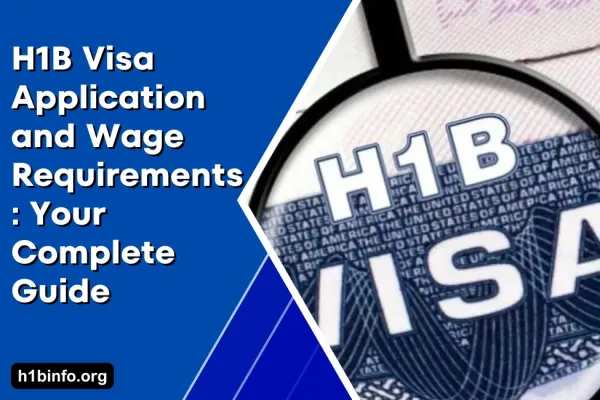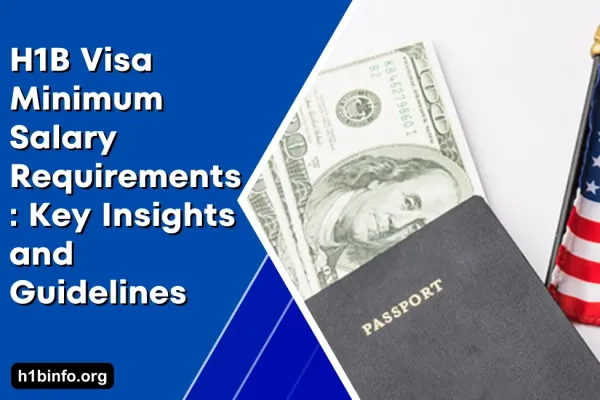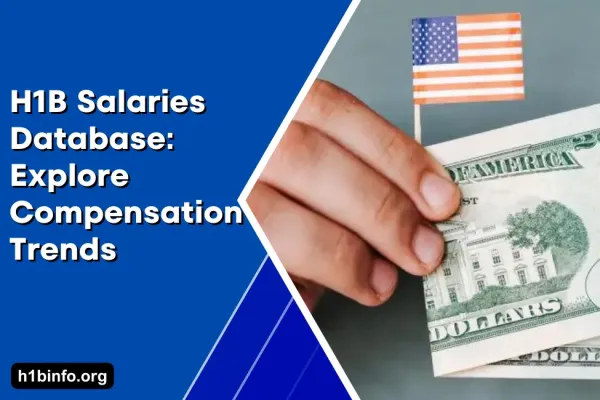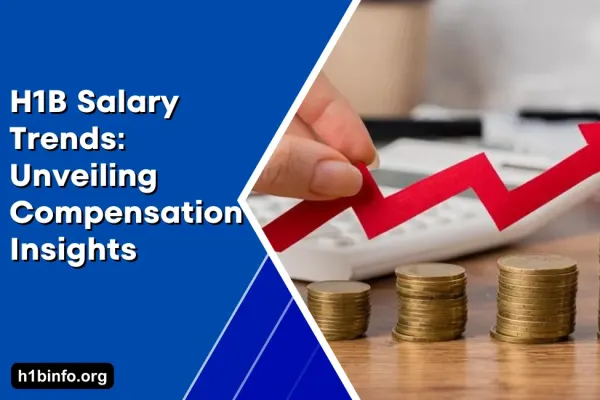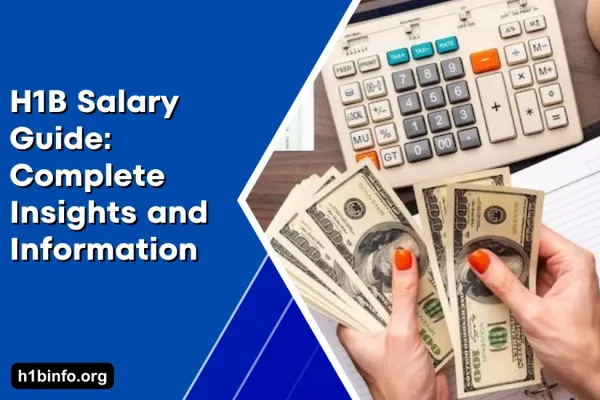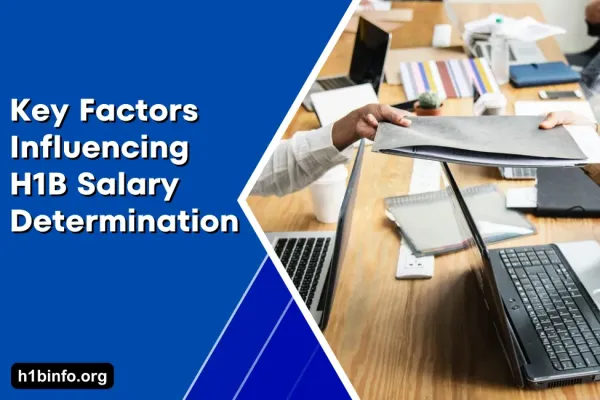The H1B visa allows people from other countries to work in special jobs in the United States. This visa covers many different types of jobs. Every year, there are 65,000 regular H1B visas available, and an extra 20,000 are set aside for people with advanced degrees.
H1B visas are very popular because they are the most common work visas for professionals and specialty workers. Many American companies and organizations use H1B visas, no matter what kind of work they do. In this guide, we'll talk about what you need to apply for an H1B visa and how the process works.
Starting with the Labor Condition Application
If you get chosen in the H1B lottery, the first thing you need to do is have a Labor Condition Application (LCA) filed for you and approved by the U.S. Department of Labor. You can't file an LCA more than 6 months before your job starts. The main goal of the LCA is to make sure you get paid at least the average wage for your job in the area where you'll be working.
It's a good idea to have an experienced immigration lawyer help with the LCA because getting all the details right is important. Once your LCA is approved, you can move forward with your H-1B application.
What Proof Do You Need for an H1B Application?
Having strong evidence is a big part of making your H1B application successful. The U.S. Citizenship and Immigration Services (USCIS) has specific requirements for the evidence you need to include with your I-129 form (Petition for a Non-Immigrant Worker). As we mentioned earlier, if your employer entered the H1B lottery and you got picked, they can file an H1B petition for you. However, there are some conditions you need to meet.
First, to get a special job, it must be a job that needs a lot of knowledge and skills. This sometimes causes arguments between the USCIS and immigration lawyers. USCIS defines a special job like this. A special job is one where you need a lot of special knowledge and skills to do it well. You also need at least a bachelor's degree or higher in a specific field to do this job in the United States.
Showing that a job is special is one reason why we need strong proof for H1B applications. Here are the things we need to show:
- Proof that the U.S. Department of Labor has approved a labor condition application (LCA).
- Proof that the job we want qualifies as a special job.
- Proof that the person who will do the job has finished the right education (at least a bachelor's degree in the United States).
- A signed agreement between the worker and the employer.
- Any licenses needed for the job (like architects needing proof of their license).
Extra proof includes a resume for the worker, records showing they can come to the United States, the worker's passport, information about the person or company asking for the H1B (like their finances, documents showing what kind of business they do, pictures, etc.), and more. These things make up a regular H1B application. If they ask for more information, we can give that too.
Since USCIS started using a new electronic system, we also need a special number to prove we signed up. If the worker needs to work in different places, we need to say where all those places are. Now, let's talk about three laws that affect H1B applications:
- The American Competitiveness and Workforce Improvement Act (ACWIA).
- The H1B Visa Reform Act of 2004.
- Public Law 114-113.
The ACWIA says that people who apply must fill out extra forms with their I-129. Right now, the cost to apply for H1B is set by these three laws. For all H1B applications, we need to pay a $460 fee with the I-129 form. There are more fees based on the situation, so check the details.
Public Law 114-113 also says that in addition to a $500 fee to prevent fraud, people who want to hire more than 50 employees in the United States and more than 50% of them have H-1B or L-1A/B status must pay an extra $4,000 fee.
What Happens After Submitting Your Application?
When you send your H1B application to USCIS, it usually takes about 3 months to a year to go through it and make a decision. However, if you're in a hurry, you can choose premium processing for an extra $2,500, and they'll get back to you within 15 days.
Sometimes, USCIS might realize they need more information to decide on your application. In that case, they'll send you a Request for Evidence (RFE), which gives you around three (3) months to provide the required documents.
FAQs
- What qualifications are needed for an H1B visa?
An American employer can request an H1B visa for a foreign worker as long as the job they're offering requires at least a bachelor's degree in a related field. Common fields include computer science, engineering, math, physical sciences, social sciences, architecture, health sciences, law, education, business, accounting, and other roles.
To qualify as a "specialty occupation," the job should either require a degree or a mix of education and relevant work experience in a closely related field. For the second option, usually, three years of related work experience can be equivalent to one year of college studies, following the 3 to 1 rule.
- How does the H1B Visa Process work?
Depending on your situation, the H1B application process generally involves three to four steps:
- Gather all the necessary information and documents for your application, including proof of education or work experience, your passport's bio-data page, and evidence of lawful status.
- Obtain certification for a Labor Condition Application (LCA) from the Department of Labor (DOL). Since 2019, this is done through the "FLAG System."
- Prepare and submit a Petition for Nonimmigrant Worker to USCIS. This includes providing supporting documents, Form I-129 and H Supplement, the certified LCA, and paying the required fees.
- If you're outside the United States, or if you've violated the terms of your current status, you may need to get an H-1B visa stamp from a U.S. Consulate abroad. This involves completing a DS-160 form, paying visa interview fees, scheduling an appointment at your local consulate, and obtaining the visa stamp.
It's essential to keep in mind that government delays can happen at any stage of the H-1B process. That's why we often recommend premium processing, where USCIS guarantees a decision within 15 days, as long as they don't need more information from your employer. This service comes with an additional $1,440 fee on top of the regular H-1B filing fees.
- How many years can I have an H1B visa?
Usually, they will give you H1B status for three years first, and then you can ask for more time, up to a total of six years. Remember, if they've approved an I-140 for you, you can even request more than six years.
- Can my employer get me a visa for less than three years?
Yes, they can. Sometimes, they might want it for a shorter period if you're doing a quick project or only working part-time. You don't have to be full-time for H-1Bs. But if they want a part-time H-1B for you, they have to prove that your main reason for being in America is the H-1B job. H-1Bs only let you work for the company that asked for the visa. But, you can have more than one H-1B visa at once, so you can work for different employers.
- How long does it take to get an H-1B visa?
The time it takes to get one can be very different. It depends on how fast the government agencies work. H-1Bs are special because not all visas need both the Department of Labor and USCIS to work together. So, if you want an H-1B, try to start the process early. But remember, you can't apply more than six months before you're supposed to start working.
- When can I begin my job with the H-1B visa?
If you're not in the U.S. or if you have a different kind of visa, like an F-1 student visa or an L-1A Intracompany Transferee visa, you can't start working for your new employer until they say yes to your H-1B request, and you officially become an H-1B worker.
But if you're changing from one H-1B job to another, you might start working for the new employer as soon as they ask for the H-1B for you. If you pay extra and they don't need more paperwork, USCIS will choose in 15 business days.
- What is the "portability" rule for H1Bs?
If you've had an H-1B visa or H-1B status before, you can start working for a new H-1B employer as soon as they ask for a new H-1B for you. And you don't even have to wait for a receipt or I-797 notice to prove they got the request. You can start as soon as you see proof that USCIS got the request. So, you can switch to a new H-1B job right away, without waiting for USCIS to approve the new request, which can take 90 days or more.
- Can I switch my H1B to a new job?
To change jobs with your H1B visa, you need to meet three conditions:
- You must have legally entered the United States, which means you didn't sneak in. Legal entry involves being processed by CBP and receiving an I-94 form (nowadays, it's digitally issued by CBP). If you're visa-exempt, there should be some other proof of legal entry.
- Your new H-1B job application must have been submitted before your authorized stay period ends. This means you should file the new H-1B petition before the end date on your first H-1B petition, as indicated on your I-94 or I-797.
- You shouldn't have worked without permission since your legal entry to the US. Before starting work under these rules, consult our office to ensure you're not breaking any H-1B rules.
- What info does my employer need to apply for an H1B?
To apply for an H-1B visa, your employer needs to provide basic information:
- When the company was founded.
- IRS identification number.
- Total number of employees.
- Net and gross annual figures, or, if it's a non-profit organization, the annual budget.
- Job title and detailed job description for the specialty worker.
- Salary for the job duties.
- Description of benefits.
- Name and title of the person signing on behalf of the employer.
- Information about the employer and the services it offers.
The company must demonstrate the ability to pay the offered salary to the H-1B employee. If your employer has fewer than 100 employees or is newly established, they may need to provide extensive documentation to prove this, such as financial statements or tax returns.
- How much should I be paid on an H-1B visa?
To protect American workers, employers applying for H-1B visas must pay H-1B employees the same rate and benefits offered to American workers in either:
- The same job position and geographic area.
- The "actual wage" previously paid to a similarly employed individual at the company, whichever is higher.
This means the mandatory wage for H-1B workers is the higher of the prevailing rate of pay or the actual wage for that position in the work area. Employers must maintain a Public Access File to prove they are paying the required wage and complying with H-1B program terms and conditions.
- How does my boss figure out what salary I should get for my H-1B job?
Remember, your employer has to pay you, the H-1B worker from another country, either (1) the wage most workers get in your job around here or (2) the actual wage they pay, whichever one is higher.
- What's the difference between the regular wage and the actual wage?
The Department of Labor says the regular wage is the pay other people in your kind of job get in this area. They figure it out using info from the Department of Labor or some other trusted source.
These sources usually do surveys about salaries in this place in the last two years. They don't include extra stuff like benefits when counting this wage. Also, your employer has to give you the same benefits as their American workers who are in the same boat, like stock options, retirement plans, and time off. If you're working at a school or a non-profit, there are some special wage rules to keep in mind.
The actual wage is how much your employer pays their other workers who have the same experience and skills for this job. When your boss talks about this job and what kind of skills and education you need, they have to compare you to other workers who are pretty much the same in these ways:
- What do you do on the job?
- How qualified you are?
- Your education?
- Your experience?
- What special stuff you know?
- Any other important business stuff?
If these similar workers get different pay, your employer has to explain why based on these factors.
To make sure American workers get fair pay, the Department of Labor doesn't want employers to pay foreign workers less. So, they make your boss keep a special record, kind of like a file people can look at, that shows why they're paying you less if they are. This record has to talk about all those factors I just mentioned and why your pay is lower.
- What is a prevailing wage, and how is it determined?
Well, a prevailing wage is the amount of money someone should be paid for their job. When it comes to H1B visas, they decide the right wage for each person on a case-by-case basis. To do this, you fill out something called an LCA, which stands for Labor Condition Application, for each employee.
Now, when you're filling out this form, they ask you to put in the wage you think is fair for the job. You can get this wage from a few different places, like the Department of Labor, the Occupational Employment Statistics program, or a trusted source. One source that lots of people use is the Foreign Labor Certification Data Center.
This Data Center helps you find out how much people usually get paid for different jobs in different places and skill levels. All you need to do is know the right area code and job code. They even break down the wages by when they collected the info.
Let's say we want to know what Computer Programmers in Los Angeles usually make. Using info from the Department of Labor, we found out that Los Angeles has a code (called the BLS code) that's 31080. Then, we can either use the SOC code (Standard Occupational Code) from the Department of Labor or search for the job manually.
Once we've got that, the FLC Data Center tells us the past wages for Computer Programmers in Los Angeles. If we're looking at data from July 2020 to now, we see that Level 1 workers usually get $65,499 a year.
But remember, there are different levels of wages depending on a person's skill and experience. So, if you're wondering about the lowest wage for an H1B worker, this info can help you out. Level 1 wages are for folks who are just starting, and 4 levels in total go up as you get more skilled and experienced.
- Why is wage data important?
This guide aims to keep things simple when explaining what the minimum H1B wage should be. However, it's essential to understand why this data matters. Let's go back to the Labor Condition Application (LCA). Everyone who files for an H1B visa must complete this application.
So, it's crucial to ensure that the wage offered is appropriate to avoid any denials. Ultimately, the Department of Labor decides if the wage is suitable for an H1B specialty occupation. That's why using a source like the FLC Data Center makes a significant difference in whether your LCA gets approved or denied. This data center collects information on prevailing wages for specialty occupations in specific areas.
The Foreign Labor Application Gateway (FLAG) is a website maintained by the Department of Labor. Here, employers, attorneys, or authorized representatives can file an LCA. You can also request a prevailing wage determination for an H1B directly from the Department of Labor through the FLAG website.
The DOL considers factors like job responsibilities, required skills, and the economic conditions in the area when assessing the wage. However, if you know the area and occupational code, you can generally use an approved source for your Labor Condition Application.
- What is the importance of the right wage level?
An H1B petition might run into problems if the employer doesn't commit to paying the wage level stated in the Labor Condition Application. Properly filing the LCA is crucial for this reason. For example, USCIS might question an employer who pays an employee more than the standard wage for an entry-level position. This discrepancy could lead to a request for additional evidence or even a denial of the petition.
If someone is seeking to extend their H1B visa and has received a raise, they must file another LCA. This is because the increased wage for the H-1B extension could be seen as an amendment.
